Best Free SEO Tools
Best Free SEO Tools : Do you think search engines like Google wait for you to gather all your marbles and then suddenly release a new update and scatter them all? Nothing confuses you more than a sudden update to Google’s algorithms. Fortunately, the best SEO or search engine optimization (SEO) tools can help you escape this mess.
It’s still unclear exactly how Google evaluates websites and displays them on the search engine results page (SERPs), but you can improve your ranking in the SERPs by improving how Google sees your site. SEO tools (free and paid) help your site to be more visible.
This article will provide 28 examples of the best free and paid SEO tools for checking and monitoring your website. Some of the free tools below also have paid versions. Therefore, check the pricing pages of your favorite tools to choose the plan and version that best suits your needs and goals.
increase the crawling and indexing speed of your site
Free SEO Tools
Some SEO tools are free to use. You may also find paid options with more features. Here are some of the best features of these tools and how to use them for your SEO strategy.
1. HubSpot Website Grader

Marketing aims to generate qualified traffic and leads through your company’s website. So, a marketer needs to know exactly how to improve the SEO of their website.
Enter your website URL into HubSpot Website Grader to automatically receive a report and adjust your SEO efforts based on the information in that report.
With HubSpot Website Grader, you can:
Website Performance: Get insights into your website’s performance in seconds, identify specific performance issues, and get clear, actionable feedback on how to fix them.
On-demand support: Learn how to improve your website.
Improve specific website issues: Access HubSpot Academy’s five-course Website Optimization course to help you understand your website’s problems.
Mobile Optimization: Learn how to optimize your website for mobile.
Increase web security: Learn how to implement best practices for website security.
Improve user experience: Customize your website’s UX to create a great user experience.
Best Free SEO Tools
2. Google Search Console
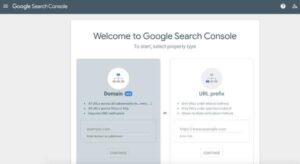
How to Become a Successful Web Designer?
Google Search Console is a free SEO tool that helps your site appear in SERPs for keywords and phrases that your audience is searching for.
Suppose you’re a business owner or an SEO on your marketing team. In that case, Search Console can help you perform a fundamental SEO analysis or update your existing SEO strategy based on new keywords. Google Search Console monitors, debugs and optimizes your website. Plus, you don’t need to know any coding to use it.
Website Elements
Here are some examples of website elements that Google Search Console can teach you about and help you optimize:
- Keywords: Learn about the keywords your web pages are currently ranking for.
- Crawl Errors: Identify any crawl errors on your website.
- Mobile Responsiveness: Learn about your website’s mobile-friendliness and find opportunities to improve your users’ mobile experience.
- Google Index: You will be informed about the number of web pages in Google’s index (if a page is not in Google’s index, you can use the URL Inspection Tool to submit it for indexing).
- Analytics and metrics: You will know the metrics related to your website that are important to you, such as clicks, impressions, average click-through rate (CTR), and average rank.
3. Google Analytics

Although Google Analytics has a paid version, the free version can help you manage your website’s SEO. This is especially true if you connect Google Analytics to Google Search Console. This brings all of your website’s SEO data together in one place, and you can use queries to identify areas for improvement in terms of keywords and phrases you want your website and web pages to rank for.
Other ways to use the free version of Google Analytics to understand and improve your website’s SEO include:
- Filtering Referral Traffic: Remove traffic that could taint your SEO reports, such as fake traffic.
- Comparing Organic and Inorganic Website Traffic: Understand where your visitors are coming from and optimize those channels to increase traffic.
- Determine engagement metrics: Use Site Content Reports to determine engagement metrics for each web page, engagement for directories and pages on your website, exit metrics, and acquisition, behavior, and conversions on landing pages.
- Review the Multi-Channel Report’s Assisted Conversions feature. Identify which channels are driving the highest conversion rates and value for your business.
4. UpCity Free SEO Report Card
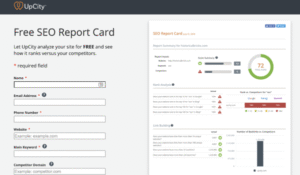
14 Reasons Why Google Isn’t Indexing Your Website
UpCity’s Free SEO Report Card is a free SEO tool that analyzes your site’s position against competitors.
In exchange for your email address and a few brief data points, the SEO Report Card provides a report that includes:
- Ranking Analysis: A snapshot of your website’s ranking on the most popular search engines.
- Link Building: The exact number of websites linking to your site.
- On-Site Analysis: A look at how successful you are at incorporating your primary keyword throughout your site.
- Website Uptime: Provides information on how quickly your site loads and is accessible.
- Trust Metrics: Provides an overview of the site’s level of trust or authority.
- Current Indexing: Indicates the number of indexed pages on your site.
Best Free SEO Tools
5. Internet Marketing Ninjas

Internet Marketing Ninjas is a company focused on various free SEO tools that you can use to compare your website to your competitors, optimize your web pages for specific keywords, generate meta tags, and increase organic traffic to your website.
Here are some examples of Internet Marketing Ninja’s free SEO tools that you can use:
- Broken Links Tool: Identify broken links and redirects and use the site crawl feature to generate an XML sitemap of your website.
- Metadata visualization: View all your page links (external, internal, etc.) on your web pages to see if they are working correctly, broken, or need updating.
- An on-page SEO optimization tool evaluates your web page content, metadata, and internal links.
- Benchmark: Compare your web pages’ SEO with your competitors’ web pages.
- Page load time: Analyze page load time and the time it takes for each page element to display fully.
6. Bing Webmaster

Microsoft’s Bing Webmaster Tools gives you access to a wide range of tools, such as reporting, diagnostics, and SEO tools, for free. With these tools, you can analyze your website, manage backlinks, and check keywords to ensure your site is optimized for organic search.
Some other things you can do with Bing Webmaster Tools SEO include:
- View your backlink profile: Get to know your referring pages, domains, and anchor links.
- Do keyword research: Determine what words and phrases your audience searches for and how much search volume they have.
- Use the site scanning feature: Crawl your website and identify technical SEO errors.
- Get SEO reports: Check your website and its pages for any errors.
7. Google Trends
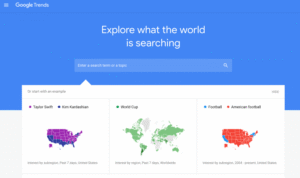
Traditional SEO tools like the ones we’ve discussed are great for conducting research and site reviews when you have an established business. But what if you’re starting a new business and want to know what industries, topics, and ideas are popular with your audience? Google Trends is a great place to uncover untapped potential that can help you determine your website’s keyword landscape.
No granular data is coming from Google Trends. This tool works best when you use it as a compass to guide your SEO strategy and pair the insights with more powerful software like HubSpot’s SEO Marketing Tool.
Here’s what you should look for in Google Trends:
- Trends: Look for trends in specific countries or regions of the world.
- Popular Topics: Find popular people and the long-tail keywords they’re related to.
- Comparisons: Focus on trends over time and compare them.
Best Free SEO Tools
8. Seolyzer
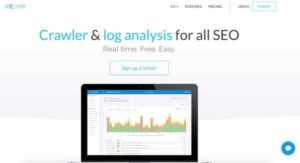
Seolyzer is a free SEO tool for crawling, log analysis, and optimization. It helps you understand how search engines like Google see your website. Seolyzer extracts information crawlers leave in server log files as they crawl your site. With this information, you can identify and create your SEO KPIs. It also detects error codes, redirects, and page speed performance.
In addition, Seolyzer helps you:
- Monitor SEO issues: Identify poor response times, error messages, and crawl volume so you can fix them before they cause severe damage.
- Manage your unique KPIs: Analyze page performance, crawl volume, HTTP status codes, active and new pages, and desktop vs. mobile responsiveness.
- Segment web pages: Identify which pages are crawled the most.
- Compare web pages: What are the most important factors Google considers when ranking essential pages for your business?
- Measure SEO impact: Check the impact of your SEO activities on a page-by-page or page-by-page basis.
9. SEOquake

SEOquake is a Google Chrome extension that automatically checks a web page’s SEO parameters quickly and for free. These parameters include on-page SEO checks, internal and external link checks, real-time URL and domain comparisons, and file data transfers.
Other things you can use SEOquake for include:
- Link analysis: The Link Examiner feature provides a detailed breakdown of how all your links, including URLs, anchor text, and other link types, are performing.
- Focus on the essential metrics: Set up SEOquake reports to show only the parameters and metrics that matter to you.
- Check your website’s SEO: Identify any SEO-related issues that are detectable by search engines.
- Share your findings with stakeholders: Turn your SEO analysis results into a customizable and shareable report.
10. Seobility
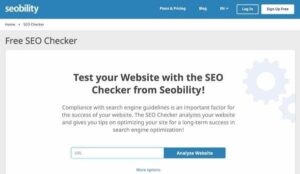
Seobility is a free SEO tool. Use it to check how well your website meets today’s SEO guidelines. Enter your URL, and your site will be analyzed. You’ll also receive tips on optimizing your website.
In addition to a detailed SEO audit of your website, you’ll get access to 1,000 subpage audit samples, email reporting and alerts, and keyword monitoring.
Some of the benefits of using Seobility are as follows:
- Find technical errors: Quickly fix on-page SEO issues to recover lost traffic and prevent future traffic drops.
- Accurate SEO scoring: The SEO score is determined based on various website factors, including metadata, page quality, link structure, and more.
- Meta data analysis: Identify specific SEO issues related to your metadata, such as invalid or incorrect meta titles or descriptions, meta tags, and domain names or URLs.
- Content optimization opportunities: Identify areas for improving page speed and quality (related to text, duplicate content, responsive design, and alt attributes for content).
- Link structure suggestions: Get data on headers, internal links, and incorrect anchor text to learn how your page and link structure can be improved.
- Fix Server Errors: Identify specific server errors related to redirect types, HTTP headers, or CSS and JavaScript files.
11. Check My Links
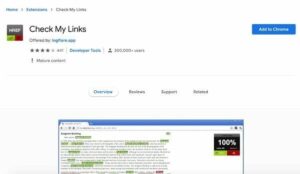
Check My Links is also a Google Chrome extension for checking the links on internal or external web pages to ensure their proper operation. For example, if you search for a term on Wikipedia, Check My Links can show you the total number of links on that Wikipedia page and the number of broken links.
This feature is helpful because you can immediately fix broken links (before publishing the page). According to the creators of Check My Links, this tool is ideal for developers, content editors, and web designers.
Here are some other examples of Check My Links’ features:
- Detect broken links: Check every link on your web pages and identify all invalid links.
- Auto-highlighting: Quickly see good links in green and broken links in red.
- Submit broken links for further analysis: Copy all your bad links to your clipboard with just one click.
12. BROWSEO

BROWSE is an SEO browser that allows you to examine your web page in a limited format. This tool allows you to analyze its UX and content and gain insights into its SEO. Once you enter the URL, the output will affect your HTML so you can understand the page’s structure, optimized search terms, and other SEO-related factors.
Examples of tasks that can be done with BROWSEO include:
- View the number of words on the page: Find the appropriate length for the text on the page.
- Determine the number of internal and external links on the page: Check the performance of the link strategy on each page.
- View all meta information: Review the title tags, alt text, and meta descriptions.